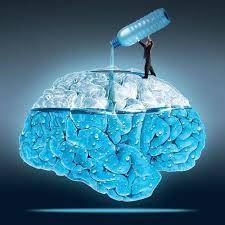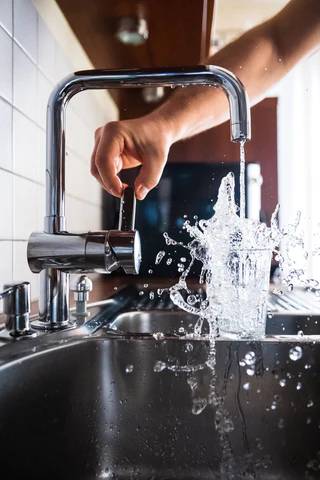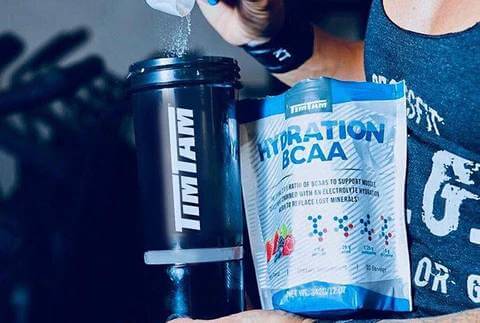What does water do for the body?
Every cell, tissue, and organ in your body - in fact all life - depends on water, the most solvent of all liquids. As you undergo intense training programs and your activity level increases, it’s going to become more important than ever to stay hydrated. Your body relies on water to function properly and not in a small way. It’s necessary for digestion and elimination, helps flush out waste and toxins, regulates body temperature, carries oxygen to cells, and much more! Our brains, lungs, and blood are composed of around 70-80-90% water respectively.¹
Without it, you’ll become dehydrated, and in severe cases of dehydration, people die. Training can be intense and strenuous. It’s tough on your body, and staying hydrated will help keep it working for you.
Some immediate effects of dehydration may be noticeable in training especially. If fogginess sets in and your heart begins to beat faster than normal, you may need to drink some liquids. Water helps keep the brain and cardiovascular system functioning optimally. Without proper hydration, the brain cannot efficiently produce hormones and neurotransmitters; resulting in impaired focus, motivation, and coordination. In addition, lack of water causes blood to become thicker in viscosity and slower in oxygen delivery. The heart must then work harder to pump the blood through the body while ultimately leading to higher energy output and quicker exhaustion.²

Dehydration doesn’t happen all at once, however, unless you’re ill, vomiting heavily, or have severe diarrhea. To help safeguard yourself, start your day by rehydrating after the nightly process of repair and restoration, and drink before and after a workout, more in extreme weather conditions.
Symptoms of dehydration can be mild to severe and can include:
- Dry mouth
- Fuzziness or inability to mentally focus
- Decreased urine output and/or urine that’s darker than normal
- Headache
- Constipation
- Dizziness or a feeling of lightheadedness
- Low blood pressure
- Rapid breathing and heartbeat at rest
- Sunken eyes
- In severe cases, convulsions or delirium
Don’t underestimate the importance of fresh water.
Almost 98% of all water on Earth is salt water. Half of what’s left is in frozen ice caps and the other half is in soil and underground aquifers.
Human composition is about 50%-79% water, with daily requirements varying depending on size, age, activity level, and external temperatures. The amount of water each of us needs on a daily basis will depend in part on our overall physical condition; whether we’re fit, overweight, ill, or recovering from an injury. People who are severely overweight are generally more dehydrated than fit bodies, and infants are especially prone to dehydration with their body weight being as much as 74% water.¹
Get water from food.
Whether you’re training or not, you’re not going to get enough water to satisfy your body’s needs from food alone, but some foods can certainly help. Taking advantage of eating nutrient dense foods with high water content will fill you up without adding a lot of calories. It’s also helpful in keeping you hydrated. Here’s a short list of foods that have high water content:³
- Foods that contain water between 91% or higher - coconut water (not coconut milk), watermelon, strawberries, cabbage, cucumber, celery, radish, iceberg lettuce, sweet pepper, eggplant, spinach, zucchini, red and green tomato, bean sprouts, okra, chard.
- Foods that contain between 81-90% water - grapefruit, cantaloupe, raspberry, plum, pineapple, pear, peach, orange, cranberry, cherry, blueberry, apricot, apple, grape, carrot, kale, onion, papaya, broccoli, parsley, pumpkin, watercress.
- Foods that contain between 71-80% water - banana, white potato, green pea, corn, sweet potato.
- Almost all fruits and vegetables contain at least 50% water.
- Herbal teas and soup broths are also an excellent way to add water to your diet.

Drink healthy water.
It should be obvious that you’ll want to drink the best water you can find, without fluoride, medical wastes, nitrates, vaccines, hormones, and many other poisonous toxins that find their way into ground water.
- Spring water - If you’re lucky enough to have your own spring or well, use it. Just be sure to test it once or twice a year. Spring water contains minerals that are removed in filtered water.
- Reverse osmosis water - You can have a system installed under the sink in your kitchen. The reverse osmosis system will remove fluoride, chemicals, metals, and organisms that are potentially harmful to the body, but all minerals will be removed as well.
- Distilled water - Distilled water has every particle removed. It’s sometimes referred to as “dead water” because it lacks oxygen and energy. It’s often used in detox programs because it attaches to electrolytes and their energy in the body, effectively pulling certain toxins out. You can add a liquid mineral concentrate to get a complete mineral array.
- Fluoride-reducing filter pitchers - These remove up to 65% of fluoride and may reduce heavy metals, chlorine, pesticides, bacteria and parasites, but will not eliminate them completely.
- Carbon block filters - These remove chemicals, hydrocarbons, chlorine and their combined byproducts. They can be found with or without lead removal capability but they’re ineffective in removing fluoride, sulfates, nitrates, arsenic, aluminum, phosphates, salts, metallic and dead dirt materials, detergents, and some medical wastes or viruses.
Get enough water.
Regardless of the type of water you choose, make sure you get enough. Guidelines suggest that water intake should be around 3.7 L for males and 2.7 L for females per day. This is how much your body needs to maintain normal bodily functions. In addition to this amount, you’ll need more water under the following conditions.⁴![]
 Activity
Activity
- Drink 8-12 ounces of water about 2 hours before a workout and another glass about 30 minutes prior to working out (this includes any activity that makes you sweat).
- If you’re active, drink 1 extra liter (~33 oz.) for every kilogram of body weight lost during activity. So make sure you monitor your weight, especially in extreme temperatures.⁴
- If you’re working out intensely or engaged in an activity that’s causing profuse sweating, use a sports drink instead of water after you workout to replace electrolytes like sodium. Coconut water is a great natural choice. Check labels on commercial sports drinks and stay away from those which are loaded with sugar, artificial ingredients and food dyes. Try Hydration BCAA by TimTam for a natural flavor, hydration blend, and BCAAs for a boost in muscle fuel and hydration.
Environment
- Hot weather causes sweating. Drink more water to replace fluids used to lower your body temperature.
- Cold weather is dehydrating, especially dry cold. It draws moisture from your skin and your lungs need to draw moisture from elsewhere in the body to function.
- Dry indoor air, whether heated or air conditioned, takes moisture from your skin which will try to compensate by taking more water from your body.
- High altitudes (8,000 feet or 2,500 meters) contain less oxygen and you’ll breathe more rapidly. Your lungs are working harder so you’ll need more water.
Fine tuning your training program includes precision in what you put into your body, and water is one of the critical elements that will help you get through the challenge.
References:
- Roland J. What is the average (and ideal) percentage of water in your body? healthline.com Web site. https://www.healthline.com/health/body-water-percentage. Updated 2019.
- Watso JC, Farquhar WB. Hydration Status and Cardiovascular Function. Nutrients. 2019;11(8):1866. Published 2019 Aug 11. doi:10.3390/nu11081866
- Popkin BM, D'Anci KE, Rosenberg IH. Water, hydration, and health. Nutr Rev. 2010;68(8):439-458. doi:10.1111/j.1753-4887.2010.00304.x
- Mayo Clinic. Water: How much should you drink every day? https://www.mayoclinic.org Web site. https://www.mayoclinic.org/healthy-lifestyle/nutrition-and-healthy-eating/in-depth/water/art-20044256#:~:text=The%20U.S.%20National%20Academies%20of,fluids%20a%20day%20for%20women. Updated 2020.


